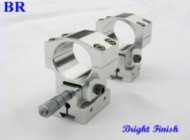Since I brought up those two points originally, I took the liberty to answer this question.
In a well-designed knob with clicks, each time you turn the knob for a click, the reticle will move a very precise amount. That amount will be something like an apparent 1/4 MOA or 1/8MOA or 0.1MIL or 0.05MIL, or the much more esoteric 1/4 IPHY or some such. Each click will signify the same amount every time. The beauty of the click is you do not have to interpret the significance of lining up 2 lines or making sure you have the markings lined up precisely the same way, edge to edge or close to the edge. You do not even have to look at the knobs with clicks, you can just feel each one, count them, and know you have dialed the exact amount that you wanted.
The nobs with the clicks also have the numbers and the lines so you are not giving up anything with the clicks. It's not an either/or situation. If I need to put in 10.5 MOA on my scope, I twirl the knob one revolution, back to the same number, then I add 4 more 1/8 clicks. That is very precise and takes all of 2.27 seconds to do. From position. if I want to go back to where I was, same thing in reverse. I don't have to look closely to make sure I have the markings lined up properly, it's digital.
The touch and feedback of the knobs clicking is what people look for and discuss when they talk about the controls of a riflescope. Do you hear and feel the clicks? Is it too mushy? Is it too hard? Do the knobs turn themselves too easily? Lots of effort has gone into quality knobs with clicks.
In PRS, going from target to target, you need to be able to crank in the correction quickly and positively. Going from 3.7 to 4.2 should not be a pain and should take nothing more than a second and you know you have the proper correction.
In F-class, when the coach says, put in 2.5 MOA right, come down 1/4 MOA and hold 2 rings right, you have to do that very quickly, without moving from your position. Extremely easy and precise to do with great knobs. I don't even want to consider doing that in a Leupold-type no-click knob.












